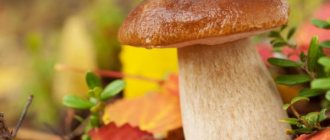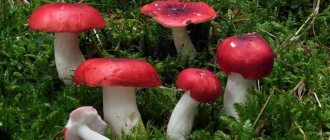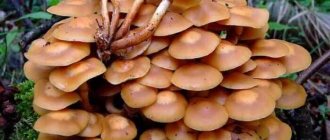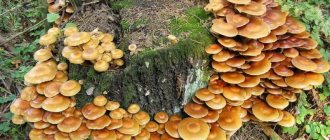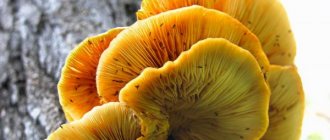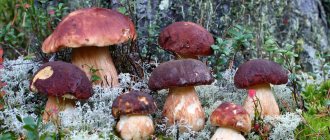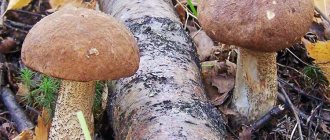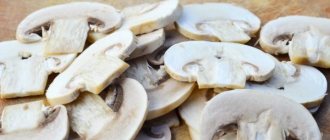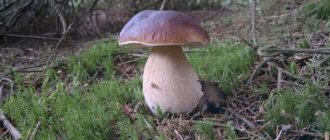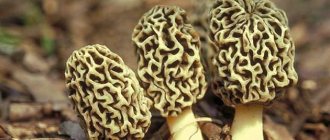Edible mushrooms growing on poplar trees
Of all the mushrooms that grow directly on poplars, the safest is oyster mushroom, since it has no poisonous counterparts. But with the rest you need to be careful.
Autumn oyster mushroom
It can be found in the forest from September to October. It grows directly on a poplar trunk, stump or dead part of a tree in a group, often fused with short legs, in the shape of a curved cylinder. In some cases the leg is missing. The length is about 3 centimeters and the width is up to 4. Also, the leg has a dense structure, covered with small scales, most often colored in yellow, brown and greenish shades.
The cap of the autumn oyster mushroom grows from the side, and has an oblong, tongue-shaped or ear-shaped shape, with a diameter of about 8 centimeters, and sometimes up to 15 centimeters. The cap of the oyster mushroom is fleshy, with white descending plates. Depending on age, the color also changes, from gray to gray-brown or ocher. The pulp is white and has no pronounced odor.
Oyster mushrooms are harvested at a young age. The advantage of this mushroom is that it is not damaged by parasites and has a rich mushroom taste. They can be distinguished from other inedible mushrooms by the skinless and fleshy structure of the flesh of the cap.
Winter honey fungus
This winter mushroom appears in late autumn and early winter, sometimes even at the end of December. Can grow under snow. Outwardly, it is similar to the summer one, the difference lies in the presence of a leg with scales and a ring, as well as a cap that is somewhat dry to the touch. The color of the legs of the winter honey fungus is dark brown or black. Closer to the top it acquires a yellow tint. The length of the leg grows from 4 to 8 centimeters, and the thickness is on average 0.5 cm.
The winter mushroom's cap diameter reaches 8 centimeters and has a dome shape (bell-shaped). The cap is covered with a sticky substance and has red, orange, brown or ocher shades. The plates are wide and often spaced, white or light ocher in color.
Winter honey fungus grows in dense clusters not only in the forest, but also in parks and gardens, usually on the south side of the tree. It is noteworthy that he has no poisonous counterparts. When preparing, you should take into account that honey fungus contains a certain amount of toxins and requires boiling for at least 20 minutes. As a rule, this time is enough for their complete destruction.
Summer honey fungus or poplar
Summer honey fungus can be found starting in June, and its fruiting lasts until October. Summer honey mushrooms can be distinguished from autumn ones by their cap. Thus, the cap of the summer honey fungus is two-colored, darker in the center and lighter at the edges. The edges are damp. When the summer is dry, the cap of the summer honey mushroom is dry. In newly grown honey mushrooms, the cap has a yellowish-brown tint, while in adults it is dark orange and brown. Autumn honey mushrooms, unlike summer ones, do not have an aggressive color. They are characterized by pastel colors.
In size and structure they do not differ from those grown in winter. Also, summer honey fungus has brown spores in large quantities.
The most poisonous counterpart of the summer honey mushroom is Galerina carinatum, and it grows only on coniferous trees. Therefore, you should not collect honey mushrooms near pine and spruce trees.
Sulfur-yellow tinder fungus
The sulfur-yellow tinder fungus is conditionally edible. This type is a wavy, multi-tiered mass of a rounded and at the same time flat shape. The color of this type of tinder fungus is bright yellow. The surface of the fruiting body is covered with yellow fluff.
The diameter of the cap can reach 15 centimeters with a thickness of 5-8 centimeters. Some fruits reach 40 centimeters in diameter. The fruits of fused caps can weigh 10 kilograms. The color of the pulp is the same bright yellow. The bottom of the cap consists of short tubes. The young mushroom has a pleasant sour taste.
The tinder fungus grows on dead or old poplar wood, sometimes on other deciduous trees. It is a parasite and destroys the tree as a result of its vital activity. The tinder fungus has an inedible counterpart - Climacodon northern, which has a paler color and characteristic spikes on the cap. The double also has an unpleasant odor.
The sulfur-yellow tinder fungus is used as food in the preparation of salads, pickles and other dishes. Its peculiarity is the need to cook for 50-60 minutes. Polypore has medicinal properties, as it contains a certain amount of antibiotic substance. It is also believed to be able to boost immunity.
Variegated tinder fungus
The variegated polypore (scaly) is also often found in nature. It is located in the lower part of the tree, sometimes at its very base, has the shape of a funnel, and over time it levels out and becomes flat. The diameter of the cap can reach 50 centimeters.
Preparing poplar rows for cooking
The taste and safety of cooked mushrooms directly depend on the preliminary stage. Since the fruiting body grows in a layer of sandy soil or forest litter, and the mushroom cap is slightly sticky, contamination is always present. High-quality peeled poplar rows according to any recipe will be well stored in winter and will not lose their taste.
How to clean a poplar row
To remove all the sand, soil particles and leaves, you will need not only a knife, but also a brush. The underside of the cap will also need cleaning. The sand remaining between the plates will not only spoil the taste of the dish, but will also shorten the shelf life of the preparations for the winter.
Methods and techniques for cleaning poplar rows:
- Using a knife, cut off the lower, harsh part of the leg, and remove spoiled, worm-eaten areas.
- If the mushroom is more than 1/3 spoiled, it is thrown away entirely.
- When dry cleaning, use a soft brush to remove dirt between the plates. If necessary, peel off the skin on the cap with a knife.
- Wetting the brush and fruiting body in sunflower oil makes cleaning easier.
The best way to remove all dirt is soaking. For quick cleaning, add 1 tbsp to 1 liter of water. l. table salt. In a few hours, all dirt will be soaked and can be easily removed with a sponge.
Is it necessary to soak the poplar row?
Water not only helps to thoroughly clean the fruiting body of the mushroom. The bitterness present in the pulp is completely eliminated by prolonged soaking. The taste acquires characteristic nutty shades, and the fruit body itself loses its fragility and becomes elastic. This allows you to keep the caps intact in the finished dish. After soaking, the pulp does not crumble due to the application of pressure in recipes for pickling and fermenting poplar rows for the winter.
How long to soak a poplar row?
Cleaned mushrooms are immersed in cold water for several days. Over the next 2 days, change the water as often as possible. This rule is especially true when it is hot. The water temperature should be maintained at +16 °C, otherwise fermentation will begin.
It is determined that the poplar mushrooms are soaked sufficiently based on the condition of the caps. When they become elastic and do not crumble when pressed, soaking is considered complete. This sometimes takes up to 3 days. Keeping mushrooms in water for a long time is mandatory for preparing first and second courses, sauces, and marinades. Pickling does not always require soaking.
How long to cook poplar row
The next mandatory step is boiling the mushrooms. The poplar row is boiled over medium heat in slightly salted water. It is advisable to accurately time the cooking time: the minimum cooking time is 20 minutes; if you heat the mushrooms for more than ½ hour, the flesh loses its elasticity.
After heat treatment, the poplar row can simply be fried with potatoes; it is ready for use in hot dishes, salads, and is suitable for pickling and salting. Mushrooms frozen at this stage will retain their consistency and taste after thawing.
What mushrooms can be found under poplars?
The most common mushrooms found in poplars in the fall are mushrooms, milk mushrooms, and boletus mushrooms.
Poplar row
The conditionally edible poplar row has the shape of a hemisphere with thin curved edges when young. Over time, the mushroom cap straightens and becomes more voluminous. The cap of the poplar row grows up to 12 centimeters in diameter.
Under the cap there are often thin plates located. The color of the plates can be white or pinkish-brown. The leg is fleshy with a scaly coating and has the shape of a cylinder. The color of the leg is pinkish-white or light brown. When the legs are squeezed, brown spots appear.
This species grows in deciduous forests, under poplars, in dense clusters. The growth period for poplar row is from August to the end of October. The row is often used for preparing various dishes. Before cooking, the mushrooms are thoroughly washed, soaked in water, and then boiled. This treatment eliminates excess bitterness.
Gray boletus
The gray boletus has a cap in the shape of a hemisphere, with curved edges, up to 15 centimeters in size. The hat has an uneven and textured surface to the touch. The color of the cap is gray or brown-gray.
The flesh of the mushroom is white, when cut, it acquires a pink tint, and after a certain period of time it turns black. Gray boletus has a pleasant aroma and taste.
The boletus leg reaches 14 centimeters and has a thickness of 4 centimeters. The upper part of the leg is gray, the lower part is brown. Also, the leg is covered with white or yellowish-brown scales. Ripens from June to the end of October. It usually grows under birch trees, but can often be found near poplar trees. Gray boletus is suitable for preparing various dishes.
Milk mushrooms aspen and blue
Aspen (poplar) milkweed grows in a dense cluster. A special feature is the presence of a large amount of white juice in it, which protects the mushroom from parasites.
The breast has a funnel-shaped cap measuring about 14 centimeters. The hat has a pink tint, is covered with fluff and is sticky to the touch. The plates are frequent, narrow and extend from the cap to the stalk. They have a white or pink tint. The leg is small, but very dense. Breast milk is more suitable for pickling because of its bitterness. It must be soaked for a long time beforehand. It is not suitable for drying.
Quite often in deciduous and mixed forests, where humidity is high, blue milk mushrooms are found. It has a convex cap, which during development takes the shape of a funnel and is covered with small scales. Its color ranges from yellow to deep yellow. With high humidity, the cap becomes sticky. The plates of this mushroom are slightly descending, thin and have a pale yellow tint.
The height of the stem of the blue milk mushroom is 4-10 centimeters, the diameter is 3 centimeters and has a light yellow color. When squeezed, the leg turns blue. Hence the name - blue milk mushroom.
The blue milk mushroom bears fruit from August until the end of November, until the first frost occurs. Milk mushrooms have a bitter taste due to the presence of milky juice. For this reason, they need careful processing. The most suitable cooking method is pickling. Only young fruits are harvested for food and processed immediately.
Where, when and how does it grow
Podtopolniks are growing almost all over the world. They can be found under poplars, in deciduous forests, in plantings along roads, in parks. These mushrooms can be collected from mid-August to October. The picky poplar mushrooms, photos of which are in the article, are capable of growing in very difficult conditions.
Poplar mushrooms very rarely grow alone. If you come across one mushroom, then you need to look for the rest nearby. Podpolniks prefer sandy soils; they can hide in it, as well as under leaves.
Inedible species
Such mushroom neighbors of poplars include scale, false valu and inedible honey fungus.
Destroying scale
It is also called poplar flake. This species, in the process of its life activity, destroys the tree on which it grows. The cap of the destructive scale reaches 20 centimeters in diameter and has a white or light yellow tint, all of it is covered with large white scales. In adult mushrooms, scales are absent, and the edge of the cap becomes uneven and fibrous. The plates of the cap are white and fused with the stem, becoming dark brown over time.
The stem of the mushroom reaches a length of 5 to 14 centimeters and 3 centimeters in diameter. The color of the stem is the same as that of the cap. It is also covered with white scales, which disappear over time. A white ring forms on the stem. Such flakes are inedible and have an unpleasant taste and smell.
False brick-red honey fungus
False honey mushrooms have a bright brick-red color and are poisonous. They are most similar to autumn honey mushrooms. In appearance, they are practically no different from edible honey mushrooms.
You should pay attention not only to the brick-red hue, but also to the fragments of the white covering layer, which remains on the edge of the cap in the form of large flakes and resembles a fringe. An important difference is the absence of a specific ring on the stem. This honey fungus selects fallen trees for growth in well-ventilated deciduous forests. If eaten, this mushroom can lead to the death of a person if medical assistance is not provided in a timely manner.
False Valuy
False valui is a dangerous poisonous species, often found in forests and fields, growing in large clusters in the autumn season.
Externally, the false valu is similar to the edible valu. But when you cut the first one, you immediately feel the characteristic pungent smell of horseradish, which quickly disappears. Another characteristic difference is that the false tree is not affected by worms. If a false representative is consumed, signs of poisoning may appear after 10 minutes, and the person requires immediate medical attention.
Nutritional value and chemical composition
Poplar mushrooms are low in calories (24 kcal per 100 grams), and in their chemical composition these mushrooms are close to meat. The row contains:
- water – 94.5%;
- proteins – 3.7%;
- fats – 0.7%;
- carbohydrates – 1.6%;
- vitamins A, C, B, PP;
- selenium;
- potassium;
- phosphorus;
- organic acids;
- enzymes that break down fats and glycogens.
Answers to common questions
There are quite a lot of species that grow on poplars and under them, most of them can be safely eaten. However, you should be careful when collecting - many mushrooms have doubles that are dangerous to health and even life.
Fungi are called arboreal because of their main feature - they penetrate the bark of a dead or living tree and decompose it using special enzymes. By destroying cellulose and other polysaccharides, they use them for their own development and growth. They belong to the group of xylotrophs.
There are edible and inedible types of these mushrooms, studied by the science of mycology. Edible parts are useful for humans, contain proteins, vitamins B and C, iron, phosphorus and calcium. “Muer” is the name of a tree mushroom translated from Chinese, which has long been often used in Pan-Asian cuisine.
Types of tree mushrooms
Mushroom hunters pay attention to apparently unusual species found in the forest on the trunks of rotten or diseased trees and dead wood. In mid-summer and autumn, you can find adult specimens of the most interesting mushrooms, a description of which is presented below.
Askokorine meat
It got its name because the fruiting body resembles pieces of meat of pink-violet shades with plates no more than a centimeter, united over one saucer. Most often found on birch stumps. Does not have a pronounced aroma. The unsightly appearance scares off mushroom gourmets, so its taste is unknown.
Bjerkandera
Belongs to the tinder family and is distinguished by tape-like growth within one year. A mature mushroom of dark brown color resembles a braid of caps, no larger than 3 cm in size. The pulp is fragile, gray in color, and odorless. A thin spore-bearing layer with a clear boundary separates the body of the mushroom from the brown oily cap, as if always wet and grayish at the ends.
Spreads on dead wood and dead wood. It tastes like regular tinder fungus.
Oyster mushroom
Oyster mushrooms quickly burst into our lives, greatly facilitating the preparation of many dishes with rare species of tree mushrooms. Growing quickly in an artificial environment, having a wonderful aroma and good taste, they have become undoubted sales leaders. Specimens bred on mushroom farms are not comparable in taste to wild varieties. They grow in large families on the trunks of living and dead deciduous fruit trees.
You need to look for them in spring and autumn in Crimea.
The fruiting body consists of a long elastic stem and a matte cap. Oyster mushrooms come in a variety of colors, from pale gray to orange, and all of them are edible and tasty.
Hypocrea
Hypoclea sulfur-yellow is an inedible parasitic mushroom that feeds on relatives of the Trembling family (most often they include Exidia glandularis). Accordingly, the seasons and places of growth of this species coincide with its “victims”.
Appearing on the body of the trembler, the hypocreas grows several yellow spots, which then merge into one surface. It forms a large golden spot on the body of the tree fungus with black dots - spore-forming fruiting bodies. It looks like a dense, uneven sponge ranging in size from 1 to 15 cm.
Ram mushroom
This fast-growing mushroom from the polypore family is also called Grifola curly. In our country it is rarely found, only in deciduous forests on old logs and stumps. Such mushrooms weighing 9-10 kg have been found in nature.
Many thin legs of the ram mushroom turn into brown caps with gray and greenish hues along the wavy edges. The light fruit body has beneficial properties and smells pleasantly of nuts.
For these properties, the mushroom is widely used in cooking and has become the medicinal basis of folk recipes for the treatment of pulmonary diseases.
Dacrimitses
A fairly rare small, up to 0.5 cm, yellow oval mushroom. It loves water, dampness and rotting stumps of coniferous trees, so in dry weather it hides in the bark of dead wood, as if spreading out and becoming flat.
Due to its yellow hue and structure, it looks like foam bubbles scattered in small drops on wood. The body of Dacrimyces has neither taste nor aroma. It is inedible, but not poisonous either.
Kalocera adhesive
In the forest, it usually settles on rotten wood and occupies this place completely, that is, other mushrooms will no longer grow here.
Kalocera strongly resembles coral, bright yellow, sometimes orange. Reaching a length of 6 cm, the horn-like processes grow together at the base and “create” a bouquet. Such formations parasitize on rotten wood and reproduce throughout the summer.
Each mushroom, rubbery to the touch, has 2-3 sharp, branched tops.
This species was classified as neither edible nor poisonous due to its rarity.
Chinese muer mushroom
The name of this delicious mushroom lies in its main place of growth - China, but sometimes it can be found in the eastern forests of Russia. It grows mainly on the trunks of living trees, preferably alder.
Brown, almost black, with a thin body, similar to an ear. Due to its delicate jelly, slightly crunchy structure and sweetish and smoky taste, muer is widely used in the cooking of China, Japan, Vietnam and Thailand.
Climacodon Northern
You can call him a real forest orderly. In mid-summer, it settles on old and diseased deciduous trees and destroys them in a couple of years. It belongs to the tinder family and looks like a very typical representative of these fungi.
The light yellow porous body and slightly brown caps of Climacodon with a radius of up to 15 cm form a multi-tiered attractive structure. In places where the spores form, they have soft spines - a rather rare occurrence for such breeds.
Its taste and smell are unpleasant, so this specimen has no experience of use in cooking or pharmaceuticals.
Honey fungus
The edible tree mushroom, familiar in appearance, taste and color to every person, is original in that it can be grown in an ordinary city apartment. And how, read on our website!) But the taste value of the found natural specimens growing on stumps and old deciduous trees is much higher.
They are found in all forests of Russia, growing in large families - up to 50 pale gray legs and gray-brown caps with one base.
tinder
There are many varieties of tinder fungi - this is one of the most popular objects of study in mycology. Its habitats are deciduous forests and parks, especially with elms.
Yellow caps with a diameter of 15 cm and brown legs 10 cm long are covered with brown scales. Those who like to cook these mushrooms need to collect only young specimens with dense, moist pulp, and up to three harvests can be taken over the summer and autumn.
Description of the mushrooms
The Oryadovaceae/Tricholomaceae family is so named not for its “love” for geometrically correct structures, but for its crowded growth. In one place, mushroom pickers sometimes collect 1.5 buckets. Poplar row is no exception in this regard.
Its Latin name is Tricholoma populinum from the genus Tricholoma. When determining a poplar row from a photo and description, it is better to rely on Latin. In regions, the mushroom is called differently:
- floodplain;
- poplar;
- subtopolevik;
- poplar row;
- sandstone;
- sandpiper;
- spoilers;
- frosties.
These are the same type of poplar rows, and not different mushrooms. But other representatives of the Tricholomaceae family can also be called sandpipers and sandpipers. The fruiting bodies of tricholomas are often “hidden” underground. Hence such strange names.
But rowers, including poisonous varieties, can be found throughout coniferous and deciduous forests. The real underwater plant belongs to the group of conditionally edible ones.
What do flood mushrooms look like?
Often poplar rows look like small mounds of earth. Some fans even look for them using rubber shoes: a hard lump can be clearly felt under the thin sole. Medium-sized leg: 2-10 cm. Most often about 4 cm high. Diameter (2-4 cm) is almost the same along the entire length. Only at the mycelium itself the stalk barely noticeably thickens.
Inside the leg is dense, without cavities, fleshy. The consistency is dry. The color is pinkish-brown (old) or pinkish-white (young). The surface can be smooth or fibrous. Covered with flocculent scales. When pressure is applied, brown spots remain on the stem.
The young topiary has a hemisphere-shaped cap. The edges are thin and curved inwards towards the stem. As it grows, the cap straightens, becomes fleshy and slightly curved. The skin is pinkish-brown. In rainy weather it becomes slippery. Cap diameter 6-12 cm.
The hymenophore of a young tortoiseshell is white; with age, the plates become pinkish-brown. The flesh is white, but under the skin of the cap it has a brownish color. At the break it turns brown. Opinions about the smell vary. Reference books usually indicate the pleasant aroma of fresh flour. But some mushroom pickers believe that the poplar row smells of soap. In fact, there is a high probability that poplar is confused with soap. The latter really smells like fruit soap.
And the reason for the discrepancies, apparently, is again confusion.
Where do floodplains grow?
Distributed in southern Russia and Siberia. They are also found in Europe. They live in symbiosis with poplars, so this species can only be found in natural poplar groves and artificial windbreaks.
The peculiarity of the poplar row is that it grows in large groups and is not found in ordinary deciduous forests. It forms a symbiosis with poplars and prefers sandy soil. But due to the fact that the experience of picking mushrooms is usually passed on from generation to generation, confusion often arises with the names. This is how various “false floodplains” appear, but in the photo in this case you can usually see a different row. And it’s also good if this species is edible.
We must remember that this row of poplars is a companion of poplars. Other rows grow in mixed and coniferous forests. Often no less tasty, but not poplar.
When floodplains grow
The collection time for floodplains is mid-August - early October. For harvesting and preparing fresh mushrooms, flood mushrooms are collected young, before the cap has yet opened. The fruiting bodies at this age are hard and contain almost no worms.
The benefits and harms of tree mushrooms
The benefits of edible species of tree mushrooms are scientifically proven. They contain absolutely no fat. Their main useful components are:
- vegetable protein;
- vitamins C, B, especially a lot of B3;
- Microelements calcium, phosphorus, iron.
In such types of mushrooms as tinder fungus, shiitake, chaga, it is not culinary, but pharmaceutical properties that predominate. Various substances and mixtures are prepared from them that can treat the symptoms of certain diseases:
- lack of iron in the blood;
- high blood pressure;
- high levels of stomach acidity;
- reduced immunity.
Tree fungi can be considered harmful only because they spread widely and quickly on healthy trees in human-cultivated areas - gardens, parks, artificial forests. Once on the bark of a damaged area of a healthy trunk, fungal spores quickly multiply and destroy it in just a few years.
If wood damaged by animals or frostbitten is treated in time with garden varnish, this danger will disappear.
Mr. Summer Resident recommends: tree mushrooms - beneficial properties, use in cooking
The tree mushroom Chaga birch has become famous for its medicinal properties - teas and decoctions from it have a powerful immunostimulating and tonic effect.
Planting mushrooms on a farm has become a profitable business and now we often see tasty and nutritious oyster mushrooms on sale, which are also classified as woody mushrooms. In nature, they come in yellow, greenish and other shades and grow in a large family. Forest species are much more fragrant than their artificially bred relatives. A big plus is that they do not have poisonous counterparts.
Tree ears, as the mushrooms are called because of their resemblance to the shell of an ear, are very popular in oriental dishes. However, they are rarely prepared as an independent dish, since they do not have a special aroma or pronounced taste. Mushrooms are good as a side dish in combination with meat, giving it a subtle smoky flavor. The crispy and dense consistency is pleasant to the taste and nutritious, especially well seasoned.
Undoubtedly, tree mushrooms have taken their rightful place in human nutrition: it is not for nothing that we are increasingly seeing them on supermarket shelves, thereby enriching the diet with healthy and nutritious protein products.
| Name: | Poplar scale |
| Latin name: | Pholiota populnea |
| Type: | Inedible |
| Taxonomy: |
|
Poplar scale is an inedible representative of the Strophariaceae family. The variety is not considered poisonous, so there are fans who eat them. In order not to be deceived in your choice, you need to be able to distinguish them by varietal descriptions, look at photos, and know the place and time of growth.
What does poplar flake look like?
The species received its name for the numerous scales covering the fruiting body, as well as for its ability to grow and bear fruit on poplar trunks and roots. Getting acquainted with scaly poplar must begin with external characteristics.
Description of the cap
The variety has a convex cap measuring 5-20 cm, which straightens over time and acquires a smooth surface. The yellow-whitish surface is covered with fibrous, pointed scales; they completely disappear with age. The pulp is white and soft. In young specimens it has a sweetish taste, in older specimens it is bitter.
The bottom is lamellar, gray-whitish plates partially adhere to the stem. In young representatives, the plates are covered with a light film, which breaks through over time and goes down. In adult specimens the ring is absent.
Description of the leg
The leg is short and thick, up to 10 cm long, about 4 cm thick. The fruit body is fleshy, fibrous with a pronounced malt aroma. The cylindrical leg is covered with dense large scales, which disappear over time.
Rules for collecting poplar rows
When collecting sandpipers in an artificial poplar strip, you need to pay attention to the distance from busy roads. You need to go deeper into the forest at a distance of at least half a kilometer. If the collection takes place in windbreaks, then you will have to go 1-1.5 km from the road, since harmful substances spread further over the fields.
It is better to collect the poplar variety of rows on a cool day after the rains. Then you can reap a truly large harvest. Only young fruiting bodies should be taken. They have pink hymenophores and caps that have not yet opened.
When you find an old specimen, it makes sense to carefully examine the area around it. Most likely, entire groups of young poplars are hiding under the soil nearby.
Doubles and their differences
The poplar flake mushroom has no poisonous counterparts. But she is often confused with a similar double.
Common scale is a conditionally edible species that grows in coniferous and deciduous forests. Fruiting lasts from July to early autumn. The mushroom has a pale yellow hemispherical cap with numerous pointed scales. The pulp is fleshy, there is no smell. In adult specimens the taste is pungent, while in young specimens it is sweetish. After a long boil, small mushrooms can be used to prepare fried, stewed and pickled dishes.
